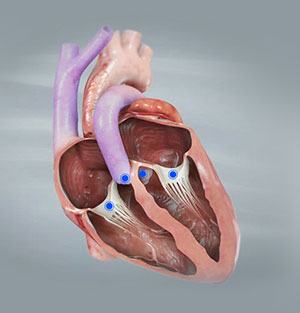
What is Valvular Heart Disease (VHD)?
The heart is an organ that pumps oxygen-rich blood to every cell in the body. The human heart is divided into four chambers, two superior atria and two inferior ventricles that are connected by four valves (mitral, tricuspid, aortic, and pulmonary). The heart valves permit the unidirectional flow of blood between the chambers of the heart.
Valvular heart disease (VHD) occurs when your heart valves do not function properly. Any damage or defect of the valve causes an abnormal blood flow through the heart. Types of heart valve disease include:
- Valvular stenosis is the narrowing of any of the heart valves causing obstruction of the blood flow.
- Valvular regurgitation or incompetence, also known as the leaky valve is a condition in which the valves do not close completely and allow the blood to leak backward into the heart.
Causes of Valvular Heart Disease
The major causes of Valvular Heart Disease include:
- Congenital heart disease (abnormal valves present at birth)
- Rheumatic fever
- Heart muscle disease (cardiomyopathy)
- Heart attack
- Advanced age
- Infection of the heart valves (endocarditis)
- High blood pressure
- Radiation therapy used to treat cancer
Symptoms of Valvular Heart Disease
The symptoms of a Valvular Heart Disease include:
- Shortness of breath
- Weakness or dizziness
- Chest pain and discomfort
- Heart palpitations
- Swelling of ankles, feet, or abdomen
- Sudden weight gain
Diagnosis of Valvular Heart Disease
The diagnosis of VHD is based on your symptoms, medical history, and physical examination.
The examination includes inspection, palpation, and auscultation of the heart. Your doctor listens to your heart sounds using a stethoscope. A murmur is an abnormal heart sound heard when the blood flows through a stenotic or leaky valve. Your doctor may order a few diagnostic tests such as:
- Echocardiography is an imaging test that uses sound waves to examine the heart anatomy and its functions.
- Electrocardiogram (ECG or EKG) is a test that records the electrical activity of the heart.
- A cardiac or treadmill stress test is used to determine the effects of exercise on the heart. It provides your doctor with information about your blood pressure, heart rate, and respiratory rate.
- Cardiac catheterization or Angiography is a diagnostic test performed to assess the heart and blood vessel conditions. A thin flexible catheter is placed through a small incision into a large artery, usually in your groin. Once the catheter reaches the site of the heart blood vessel to be viewed, a contrast material is injected and X-ray images are taken.
Treatment of Valvular Heart Disease
The treatment of valvular heart disease depends on the cause and severity of the symptoms.
- Lifestyle modifications such as eating a healthy diet low in salt and fat, exercising regularly, maintaining a healthy weight, quitting smoking, and managing stress will help slow the progression of your heart disease.
- Your doctor may prescribe medications to improve your cardiac health.
- Surgery is indicated when conservative treatment measures fail to relieve cardiac symptoms.
The surgical options depend on the patient’s age and health status and may include:
- Percutaneous balloon valvotomy is a procedure in which a balloon is placed across the stenosed valve and inflated. This results in the widening of the valve and smooth blood flow.
- Minimally invasive heart valve surgeries to repair or replace the damaged heart valves.
Types of Surgery for Valvular Heart Disease
There are two different types of valve surgery:
Valve Repair: This is often performed for valves with mild to moderate damage.
Valve Replacement: This is performed for seriously damaged valves. Here the diseased valve is removed and replaced with a new valve. The replacement valves can either be biological or mechanical valves.
The need for heart valve repair or replacement depends on many factors, such as the type, cause, and severity of the valve disease, the symptoms, and the general overall health of the patient. Valvular surgery helps to reduce the symptoms and improve the quality of life.
